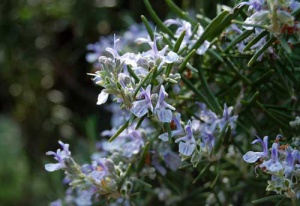Rosemary
Contents
Habitat & Description
Rosemary is a member of the mint family Lamiaceae. It is native to Mediterranean regions, but it can be cultivated easily in many other areas. It has a distinctly woody taste and fragrant evergreen needle-like leaves. Flowers can be white, pink, purple or blue in color. The parts most used for culinary and medicinal purposes are the leaves and twigs. Other common names are compass-weed, poplar plant and old man.
Constituents & Actions
Rosemary contains volitile oils partially composed of borneol, camphene, cineole, camphor, limonene, isobutyl acetate, terpineol, 3-octanone, etc.
Rosemary also consists of phenolic acids, including rosmarinic acid. Flavonoids included are; apigenin, diosmetin, diosmin, hispidulin, 6- methoxygenkwanin, genwanin, sinensetin, luteolin and associated derivatives.
Diterpenes such as picrosalvin, carnosic acid and rosmariquinone are included along with rosmaricine, triterpenes, ursolic acid and oleanolic acid and derivatives.
Rosemary is effective as a carminative (relieves intestinal gas pain and distension), anti-depressive, rubefacient (stimulates blood flow to the skin, causing local reddening), anti-spasmotic (prevents and relieves spasms), anti-microbial, diuretic (increases the secretion and flow of urine) and emmenagogue (facilitates and regulates menstrual flow). It is also high in iron, calcium and vitamin B6.
Medicinal Uses
Rosemary contains carnosic acid (CA) which helps fight off free radical damage in the brain. It is very effective in treatment and prevention of stroke, alzheimer's disease and dementia. When combined with skullcap, kola and oats, it may be useful in helping with depression.
Rosemary has been known to prevent breast cancer in women, which is caused by an imbalance of estrogen hormones. The drug most used as an estrogen blocker is tamoxifen, which has side-effects such as hot flashes, vaginal bleeding, headaches and nausea. Rosemary is a safer alternative to inactivate excess estrogen in the body.
Rosemary is also known to benefit the liver, by helping eliminate toxins. Since it is also a diuretic, it is very valuable in cases of water retention as seen with swollen ankles and bloating. Rosemary can also improve kidney function.
As a circulatory and nervine stimulant, it has a calming effect on the digestion. It has been used in cases where physological tension is present such as instances of flatulence, dyspepsia, headache or depression associated with debility.
Externally, Rosemary can be useful in easing muscular pain, sciatica and neuralgia. It's also a stimulant to hair follicles and scalp circulation, therefore it may be helpful in premature balding, the oil is most effective in this area.
Preparation & Dose
To make an infusion, pour one cup of boiling water onto 1-2 teaspoons of dry herb, and leave to infuse in a covered container for 10-15 minutes, this can be taken three times per day. The tincture can be used in the dose of 1-2ml, 3x's daily.
Side-Effects & Interactions
The side-effects of Rosemary are minimal. Rarely there is a skin reaction to topical application, and this herb can interfere with iron absorption, so those with iron deficiency anemia should use caution.
